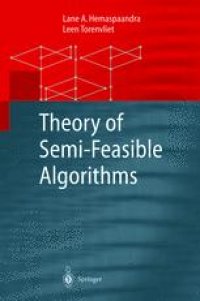
Ebook: Theory of Semi-Feasible Algorithms
- Genre: Mathematics // Algorithms and Data Structures
- Tags: Algorithm Analysis and Problem Complexity, Computation by Abstract Devices, Discrete Mathematics in Computer Science, Algorithms, Combinatorics
- Series: Monographs in Theoretical Computer Science. An EATCS Series
- Year: 2003
- Publisher: Springer
- Language: English
- pdf
This book presents a consolidated survey of the vibrant field of research known as the theory of semi-feasible algorithms. This research stream perfectly showcases the richness of, and contrasts between, the central notions of complexity: running time, nonuniform complexity, lowness, and NP-hardness. Research into semi-feasible computation has already developed a rich set of tools, yet is young enough to have an abundance of fresh, open issues.
Being essentially self-contained, the book requires neither great mathematical maturity nor an extensive background in computational complexity theory or in computer science in general. Newcomers are introduced to the field systematically and guided to the frontiers of current research. Researchers already active in the field will appreciate the book as a valuable source of reference.
This book presents a consolidated survey of the vibrant field of research known as the theory of semi-feasible algorithms. This research stream perfectly showcases the richness of, and contrasts between, the central notions of complexity: running time, nonuniform complexity, lowness, and NP-hardness. Research into semi-feasible computation has already developed a rich set of tools, yet is young enough to have an abundance of fresh, open issues.
Being essentially self-contained, the book requires neither great mathematical maturity nor an extensive background in computational complexity theory or in computer science in general. Newcomers are introduced to the field systematically and guided to the frontiers of current research. Researchers already active in the field will appreciate the book as a valuable source of reference.
This book presents a consolidated survey of the vibrant field of research known as the theory of semi-feasible algorithms. This research stream perfectly showcases the richness of, and contrasts between, the central notions of complexity: running time, nonuniform complexity, lowness, and NP-hardness. Research into semi-feasible computation has already developed a rich set of tools, yet is young enough to have an abundance of fresh, open issues.
Being essentially self-contained, the book requires neither great mathematical maturity nor an extensive background in computational complexity theory or in computer science in general. Newcomers are introduced to the field systematically and guided to the frontiers of current research. Researchers already active in the field will appreciate the book as a valuable source of reference.
Content:
Front Matter....Pages i-x
Introduction to Semi-Feasible Computation....Pages 1-16
Advice....Pages 17-40
Lowness....Pages 41-59
Hardness for Complexity Classes....Pages 61-78
Closures....Pages 79-103
Generalizations and Related Notions....Pages 105-113
Back Matter....Pages 115-149
This book presents a consolidated survey of the vibrant field of research known as the theory of semi-feasible algorithms. This research stream perfectly showcases the richness of, and contrasts between, the central notions of complexity: running time, nonuniform complexity, lowness, and NP-hardness. Research into semi-feasible computation has already developed a rich set of tools, yet is young enough to have an abundance of fresh, open issues.
Being essentially self-contained, the book requires neither great mathematical maturity nor an extensive background in computational complexity theory or in computer science in general. Newcomers are introduced to the field systematically and guided to the frontiers of current research. Researchers already active in the field will appreciate the book as a valuable source of reference.
Content:
Front Matter....Pages i-x
Introduction to Semi-Feasible Computation....Pages 1-16
Advice....Pages 17-40
Lowness....Pages 41-59
Hardness for Complexity Classes....Pages 61-78
Closures....Pages 79-103
Generalizations and Related Notions....Pages 105-113
Back Matter....Pages 115-149
....